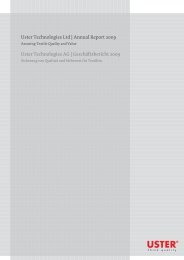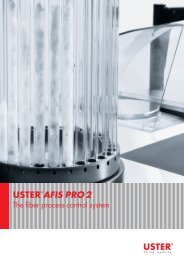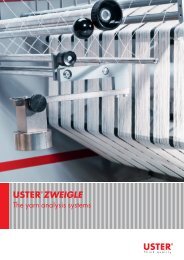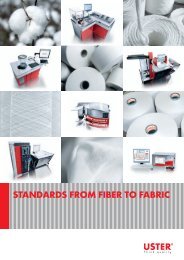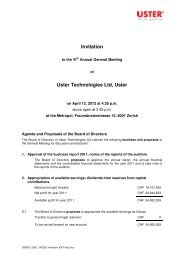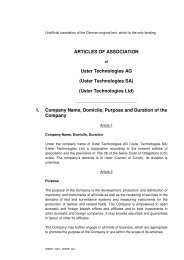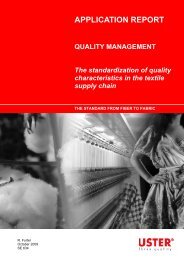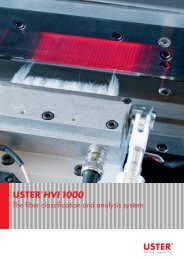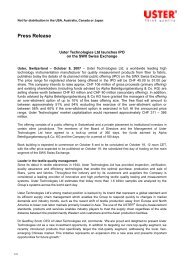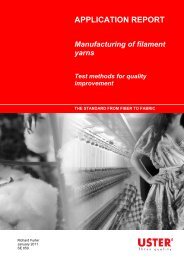Application Handbook_Uster_Statistics - Uster Technologies
Application Handbook_Uster_Statistics - Uster Technologies
Application Handbook_Uster_Statistics - Uster Technologies
- No tags were found...
You also want an ePaper? Increase the reach of your titles
YUMPU automatically turns print PDFs into web optimized ePapers that Google loves.
5 RestrictionsThis section addresses the restrictions that apply to the use of the USTER ® STATISTICS and wewould like to repeat our advice that this be read carefully and adhered to. Both deliberate andunintentional misuse of the STATISTICS have in some instances in the past resulted in lengthy andcostly disputes – all of which could have been avoided if all parties involved would have had the sameclear understanding of the concept underlying the STATISTICS. The reading of this section is a mustfor those who are not familiar with that concept, with the STATISTICS as such, or with the properinterpretation of the data.5.1 Restrictions Imposed by the Raw MaterialFour primary variables have a decisive impact on corporate success in our textile environment as wellas in any other industrial venture: man, machine, material, and know-how or information in general.Among these four key elements, the raw material is the crucial component which largely dictatesquality but also productivity and cost in yarn manufacturing. By virtue of their design, the USTER ®STATISTICS for spun yarns do not provide direct access to information about the raw material usedfor spinning. However, those differences in raw material usage are indirectly reflected in the data. Ahigh-quality yarn can only be spun from high-quality raw materials and since the raw materialfrequently accounts for more than 50% of the total manufacturing costs in the medium to fine countrange, the utilization of high-quality, high-priced raw materials will be proportionally reflected in theyarn price. Any measures taken in the field of raw materials will not only have a considerable impacton quality but also on a mill’s competitiveness and bottom-line performance.In those rare cases where the STATISTICS have been corrupted, the motives have always beenrelated to what evidently is the single most important driving force in the global textile scenario: price.The USTER ® STATISTICS, however, provide a dependable indication of quality, exclusively. Althoughquality is a somewhat elusive term, it is nevertheless a result of tangible assets and thus to a certaindegree interrelated with the sales price of a product (more details and examples are available inUSTER ® NEWS BULLETIN No. 49).The USTER ® STATISTICS should not be interpreted as saying 5% is “good”. In contrary, the 5% linemight be indicative of high cost, high price, luxuriousness – even a tendency to price oneself out ofthe market. By the same token, 95% should not imply “poor” – it might be indicative of a veryattractive price and just the right quality for the target markets. A “good” spinner is actually one who isin a position to achieve an acceptable quality level from a less expensive fiber – the genuine masteryof spinning. The trouble starts when the USTER ® STATISTICS are referred to in order to corroboratecomplaints about a low rating in certain quality categories. This complaint may be directed at the“good” spinner who produces a reasonably priced yarn from a reasonably priced fiber. Yarn price,however, is directly proportional to fiber quality and fiber quality in turn dictates yarn quality to a greatextent. Consequently, pushing yarn quality towards better values would simply cannibalize the priceadvantage. The USTER ® STATISTICS should be employed as what they really are: a global survey ofyarn quality as produced in every part of the world. Whether or not these qualities are producedeconomically from adequate raw materials and offered at a legitimate price is certainly beyond thescope of the STATISTICS.USTER ® STATISTICS 31 (36)



